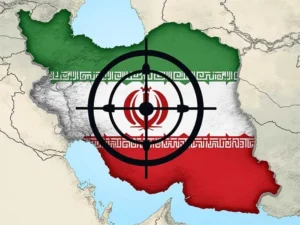The Middle East as a Zone Free of Nuclear Weapons
TRANSCEND MEMBERS, 16 Jun 2025
Jan Oberg, Ph.D. | Transnational Foundation – TRANSCEND Media Service
Why the focus ought to be on Israel, not Iran. Israel has 90-400 nuclear weapons. Here is what a simple AI dialogue yields. Any journalist could do it. No one does.
15 Jun 2025 – The UN General Assembly Resolution that declares the Middle East a zone free of nuclear weapons is UN General Assembly Resolution A/RES/76/30.
Title: Establishment of a nuclear-weapon-free zone in the region of the Middle East.
Date: Most recently adopted on 6 December 2021 (and reaffirmed annually with updates)
Original Adoption: First introduced in 1974 (Resolution A/RES/3263 (XXIX))
This resolution:
- Calls for the establishment of a nuclear-weapon-free zone (NWFZ) in the Middle East.
- Urges all states in the region to place all their nuclear activities under International Atomic Energy Agency (IAEA) safeguards.
- Reaffirms that the non-proliferation of nuclear weapons in the region contributes to international peace and security.
While it is not legally binding, it reflects strong international consensus and is reaffirmed annually by the UN General Assembly, usually with overwhelming support.
Connection to the Non-Proliferation Treaty (that Iran has signed but not Israel):
The Treaty on the Non-Proliferation of Nuclear Weapons (NPT), particularly Article VII, encourages the establishment of regional nuclear-weapon-free zones (NWFZs). The idea of a Middle East NWFZ was first proposed in the 1974 General Assembly Resolution A/RES/3263 by Egypt and Iran.
Here’s how they relate:
- NPT Commitments:
- Non-nuclear-weapon states under the NPT agree not to develop or acquire nuclear weapons.
- Nuclear-weapon states (U.S., Russia, China, UK, France) agree to pursue disarmament and to help non-nuclear states use nuclear energy peacefully.
- Middle East NWFZ Goal:
- The NWFZ resolution builds on this by aiming for a region-wide ban on nuclear weapons, addressing concerns that Israel, which is widely believed to possess nuclear weapons but is not a party to the NPT, remains outside the regime.
- 1995 NPT Review Conference Resolution:
- A key decision during the 1995 NPT Review Conference extended the NPT indefinitely conditioned on progress toward a Middle East NWFZ.
- This made it a political obligation, especially for the nuclear-weapon states, to facilitate such a zone.
UNGA Voting on Resolution A/RES/76/30 (Example from 2021)
This resolution is adopted annually with wide support. Here’s how the 2021 vote (Resolution 76/30) went:
- Votes in Favor: 178
- Votes Against: Israel
- Abstentions: United States
💬 Notable Positions:
- Israel: Votes against the resolution every year. It has not signed the NPT and maintains a policy of nuclear ambiguity.
- United States: Typically abstains, citing that such initiatives should include all regional states in negotiations, and often expressing concern that the resolution singles out Israel.
- Arab States, Iran, and many others: Strongly support the resolution, viewing it as essential for regional and global security.
- Despite the repeated UNGA resolutions and support from nearly all states, the Middle East remains the only region without a NWFZ, largely due to:
- Lack of regional consensus.
- Israel’s position on nuclear weapons and refusal to join the NPT.
- Security concerns among Gulf states.
Here is Wikipedia’s very comprehensive account of Israel’s nuclear weapons and how it acquired them. It seems to have between 90 and 400 nuclear weapons.
Here is ICAN’s report from September 2024.
__________________________________________
 Prof. Jan Oberg, Ph.D. is director of the independent Transnational Foundation for Peace & Future Research-TFF in Sweden and a member of the TRANSCEND Network for Peace Development Environment. CV: https://transnational.live/jan-oberg
Prof. Jan Oberg, Ph.D. is director of the independent Transnational Foundation for Peace & Future Research-TFF in Sweden and a member of the TRANSCEND Network for Peace Development Environment. CV: https://transnational.live/jan-oberg
https://transnational.live.
Go to Original – thetransnational.substack.com
Tags: Iran, Israel, Nuclear Free Middle East, Nuclear Weapons, Nuclear club
DISCLAIMER: The statements, views and opinions expressed in pieces republished here are solely those of the authors and do not necessarily represent those of TMS. In accordance with title 17 U.S.C. section 107, this material is distributed without profit to those who have expressed a prior interest in receiving the included information for research and educational purposes. TMS has no affiliation whatsoever with the originator of this article nor is TMS endorsed or sponsored by the originator. “GO TO ORIGINAL” links are provided as a convenience to our readers and allow for verification of authenticity. However, as originating pages are often updated by their originating host sites, the versions posted may not match the versions our readers view when clicking the “GO TO ORIGINAL” links. This site contains copyrighted material the use of which has not always been specifically authorized by the copyright owner. We are making such material available in our efforts to advance understanding of environmental, political, human rights, economic, democracy, scientific, and social justice issues, etc. We believe this constitutes a ‘fair use’ of any such copyrighted material as provided for in section 107 of the US Copyright Law. In accordance with Title 17 U.S.C. Section 107, the material on this site is distributed without profit to those who have expressed a prior interest in receiving the included information for research and educational purposes. For more information go to: http://www.law.cornell.edu/uscode/17/107.shtml. If you wish to use copyrighted material from this site for purposes of your own that go beyond ‘fair use’, you must obtain permission from the copyright owner.
Join the discussion!
We welcome debate and dissent, but personal — ad hominem — attacks (on authors, other users or any individual), abuse and defamatory language will not be tolerated. Nor will we tolerate attempts to deliberately disrupt discussions. We aim to maintain an inviting space to focus on intelligent interactions and debates.
